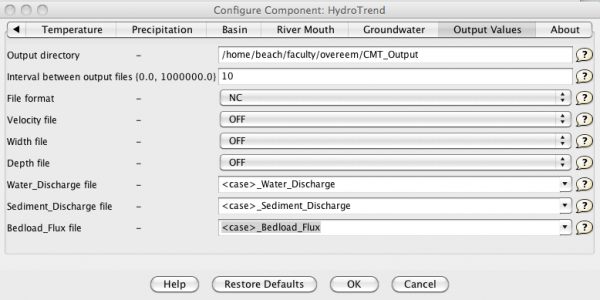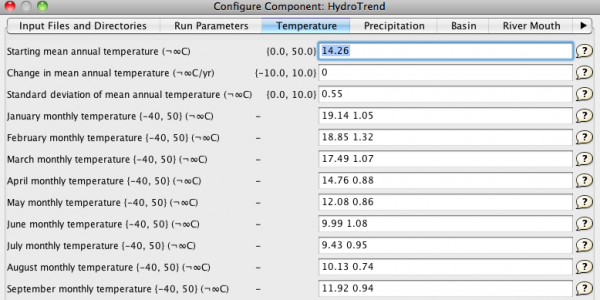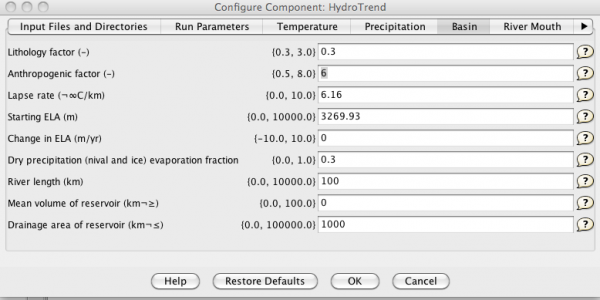Labs River Sediment Supply
River Sediment Supply Modeling with HydroTrend
If you have never used CMT, learn how to use it here.
To learn more about HydroTrend and its approach to sediment supply modeling, you can download this presentation.
We are using a theoretical river basin of ~1990 km2, with 1200m of relief and a river length of ~100 km. All parameters that are shown by default in the CSDMS Modeling Tool for the HydroTrend Model SetUp are based on a present-day, temperate climate.
>> Open Project: go to Group Courses, Select NCED2012 project.
>> Set a unique remote working directory for each of these experiments.
>> Having a unique directory will mean you keep your output organized per experiment and files will not get overwritten.

>> For this specific exercise we will be running HydroTrend in stand-alone mode. This means that you only drag the HydroTrend Component from the Component Palette into the Driver Palette.
>> HydroTrend will now be active in the CMT Arena. The HydroTrend Configure Menu is used to set the parameters for the simulations. You can set the parameters by going through the different tabs under the configure menu and subsequently run it by hitting the blue run button. (If you do not see a 'run' button that means you installed Hydrotrend as a component, to fix that you can remove it and drag it from the palette to the driver space).
Exercise 1: Explore the base-case river simulation
>> Run a “base-case” simulation for 100 years at daily time-step.
>> To run the base case scenario. Make sure you have the input files and directories tab of the ‘Configure Menu” set to GUI. This means that the input to the model is being received from the GUI. Here you can specify your simulation name. The output files are then automatically tagged with this identifier.
>> Set a base case scenario for 100 years.
>> Specify a number of output files to generate after the simulation: these are netCDF files of water discharge, suspended sediment, and bedload. Switch the output interval to 1 (every timestep).


>> Now run the simulation!
>> Download the output files with remote file transfer. You can download the netCDF files and use VisIT to visualize your results, or grab the ASCII files and use Excell or Matlab to import the data.
Question 1a Calculate mean water discharge Q, mean suspended load Qs, mean sediment concentration Cs, and mean bedload Qb. Note all values are reported as daily averages. Q= m3/s, Cs=kg/m3, Qs =Qb = kg/s.
Question 1b Identify the 100-year flood event for this simulation. Plot the year of Q-data which includes the flood.
Question 1c Calculate the mean annual sediment load for this river system.
Question 1d To compare the mean annual load to other river systems you will need to calculate its sediment yield. Sediment Yield is defined as sediment load normalized for the river drainage area; so it can be reported in T/km2/yr. How does this compare to the present-day Mississippi River?
Exercise 2: How does a river system respond to climate change; a few simple scenarios for the coming century.
Now we will look at changing climatic conditions in a small river basin. We'll change temperature and precipitation regimes and compare discharge and sediment load characteristics to the original basecase. And we will look at the are potential implications of changes in the peak events.
>>Use the temperature and precipitation tabs to modify the mean annual temperature T, the mean annual precipitation P, and its the variability of the yearly means through the standard deviation. You can specify trends over time, by modifying the parameter ‘change in mean annual temperature’ or ‘change in mean annual precipitation’. HydroTrend runs at daily timestep, and thus can deal with seasonal variations in temperature and precipitation for a basin. The model ingests monthly mean input values for these two climate parameters and their monthly standard deviations, ideally the values would be derived from analysis of a longterm record of daily climate data. You can adapt seasonal trends by using the monthly values.
Question 2a Explore the effect of a warming climate. What happens to discharge, suspended load and bedload if the mean annual temperature in this specific river basin increases by 4 °C?
Question 2b Explore the effect of a 100% increase of precipitation in the next century. How much increase of discharge do you see after 100 years? How is the average suspended load affected? How does the bedload change? What happens to the peak event, look at the highest event of the last 10 years of the simulation?
Question 2c In addition, climate model predictions indicate that perhaps precipitation intensity and variability could increase. How would you model this; discuss all your input settings for precipitation?
Exercise 3: How do humans affect river sediment loads?
Here we will look at the effect of human in a river basin. Humans can accelearate erosion processes, or reduce the sediment loads traveling through a river system. Both concepts can be simulated, first run 3 simulations systematically increasing the anthropogenic factor (0.5-8.0 is the range).
Question 3a Describe in your own words the meaning of the human-induced erosion factor, (Eh) (Syvitski & Milliman, 2007). This factor is parametrized as the “Antropogenic” factor in HydroTrend. See references for the paper.
>> Model a scenario of a drinking water supply reservoir to be planned in the coastal area of the basin. The reservoir would have 800 km 2of contributing drainage area and be 3 km long, 200m wide and 100m deep. Set up a simulation with these parameters.
Question 3b How would such a reservoir affect the sediment load at the coast (i.e. downstream of the reservoir)?


